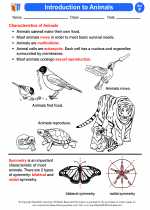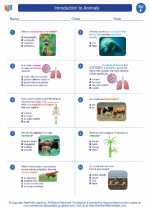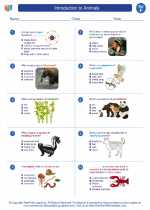Mammals
Mammals are a group of animals that belong to the class Mammalia. They are characterized by several unique features, including the presence of mammary glands, hair or fur covering the body, and a specialized middle ear for hearing. Mammals are also warm-blooded, meaning they can regulate their own body temperature.
Characteristics of Mammals
1. Mammary Glands: Mammals have mammary glands, which are specialized organs that produce milk to nourish their young.
2. Hair or Fur: Most mammals have hair or fur covering their bodies, which helps to insulate and protect them from the environment.
3. Specialized Middle Ear: Mammals have three middle ear bones (the malleus, incus, and stapes) that transmit sound vibrations from the eardrum to the inner ear, allowing for sensitive hearing.
4. Warm-Blooded: Mammals are endothermic, meaning they can generate their own body heat and maintain a relatively constant internal temperature, regardless of the external environment.
Classification of Mammals
Mammals are further classified into different groups based on their characteristics. The main groups of mammals include:
- Monotremes: These are egg-laying mammals, such as the platypus and echidna.
- Marsupials: Marsupials give birth to relatively undeveloped young, which then continue to develop in a pouch, such as kangaroos, koalas, and opossums.
- Placentals: Placental mammals give birth to well-developed young that are nourished in the womb through a placenta, such as humans, dogs, cats, and whales.
Importance of Mammals
Mammals play crucial roles in ecosystems and the environment. They contribute to seed dispersal, pollination, and control of insect populations. Many mammals are also important for ecological balance and are valuable in scientific research and conservation efforts.
Study Guide
- What are the defining characteristics of mammals?
- How are mammals classified, and what are the main groups of mammals?
- Discuss the importance of mammals in ecosystems and the environment.
- Identify and describe three different types of mammals, including examples of each.
- Explain the significance of mammary glands in mammals and their role in reproduction.
Understanding the unique characteristics and classifications of mammals is essential for comprehending the diversity and significance of this fascinating group of animals.
.◂Science Worksheets and Study Guides Sixth Grade. Introduction to Animals

 Activity Lesson
Activity Lesson
 Worksheet/Answer key
Worksheet/Answer key
 Worksheet/Answer key
Worksheet/Answer key
 Worksheet/Answer key
Worksheet/Answer key
 Vocabulary/Answer key
Vocabulary/Answer key
 Vocabulary/Answer key
Vocabulary/Answer key
 Vocabulary/Answer key
Vocabulary/Answer key
 Vocabulary/Answer key
Vocabulary/Answer key
